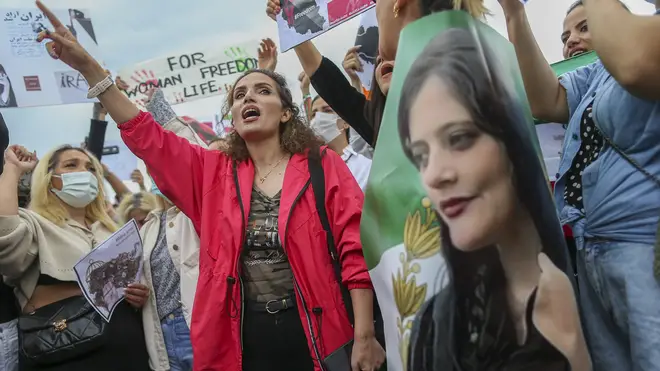
Nick Ferrari 7am - 10am
3 October 2022, 13:54

Mahsa Amini died in the custody of Iran’s morality police in Tehran, sparking weeks of protests.
Iran’s supreme leader Ayatollah Ali Khamenei has responded publicly to the biggest protests seen in the country in years following the death in custody of a 22-year-old woman by saying the unrest had been planned by the US and Israel.
Khamenei described the death of Mahsa Amini in Tehran while she was in the custody of Iran’s morality police, which set off weeks of nationwide protests, as “a sad incident” that “left us heartbroken”.
However, he sharply condemned the protests as a foreign plot to destabilise Iran, echoing authorities’ previous comments.

“This rioting was planned,” he told a cadre of police students in Tehran.
“I say clearly that these riots and insecurities were designed by America and the Zionist regime, and their employees.”
He added of the protests: “Such actions are not normal, are unnatural.”
His comments come as nationwide protests sparked by Ms Amini’s death entered a third week despite the government’s efforts to crack down on them.
Women in #Iran have been tortured, violently assaulted and sexually abused by security forces. The international community must take action. #ProtectTheProtest ✊ pic.twitter.com/9jCzPfXKVT
— Amnesty International (@amnesty) October 2, 2022
Authorities have repeatedly blamed foreign countries and exiled opposition groups for fanning the unrest, without providing evidence.
The protests over Ms Amini’s death have tapped into a deep well of grievances in Iran, including the country’s surging prices, high unemployment, social restrictions and political repression.
Demonstrations have continued in Tehran and far-flung provinces even as authorities have restricted internet access to the outside world and blocked social media apps.

Thousands of Iranians have taken to the streets to protest over the death of the 22-year-old, who had been detained by Iran’s morality police in the capital Tehran for allegedly not adhering to Iran’s strict Islamic dress code.
The protesters have vented their anger over the treatment of women and wider repression in the Islamic Republic. The nationwide demonstrations rapidly escalated into calls for the overthrow of the clerical establishment that has ruled Iran since its 1979 Islamic revolution.
Demonstrations against Ms Amini’s death have also taken place in other countries including Turkey, Lebanon and France.

Meanwhile, Sharif University of Technology in Tehran announced that only doctoral students would be allowed on campus until further notice following hours of turmoil on Sunday evening, when witnesses said anti-government protesters clashed with hard-line pro-establishment students.
One witness said police kept hundreds of students holed up on campus and fired rounds of tear gas to disperse the demonstrations.
The university’s student association said that police and plainclothes officers surrounded the school from all sides and detained at least 300 students as protests rocked the campus after nightfall.
Plainclothes officers beat a professor and several university employees, the association reported.
The state-run IRNA news agency sought to downplay the violent stand-off, reporting a “protest gathering” took place and ended without casualties.
But the violent crackdown drew condemnation even from the Jomhouri Eslami daily, a hard-line Iranian newspaper.

“Suppose we beat and arrest, is this the solution?” a column asked. “Suppose that is preventative. But will it be constructive?”
Demonstrations over Ms Amini’s death have grown into an open challenge to the Iranian leadership, with chants of “Death to the dictator”, echoing from the streets and balconies after dark.
Security forces have responded to the unrest with tear gas, metal pellets and in some cases live fire, according to rights groups and widely shared footage, although the scope of the crackdown remains unclear.
Iran’s state TV has reported the death toll from violent clashes between protesters and the security officers could be as high as 41. Rights groups have given higher death counts, with Amnesty International saying it has identified 52 victims, including five women and at least five children.
Remember their names.
📢 Take action now. https://t.co/F1ScjFyEdM #مهسا_امینی #MahsaAmini pic.twitter.com/79zfvMqCiY
— Amnesty Iran (@AmnestyIran) September 30, 2022
An untold number of people have been apprehended, with local officials reporting at least 1,500 arrests.
Security forces have picked up artists and activists who have voiced support for the protests, as well as dozens of journalists. Most recently on Sunday, authorities arrested Alborz Nezami, a reporter at an economic newspaper in Tehran.
Khamenei warned that that those who foment unrest to “sabotage” the country deserve “harsh prosecution and punishment”.
Young people who “come to the streets after excitement after watching something on the internet”, he added, should be “disciplined”.